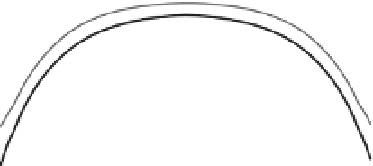Agriculture Reference
In-Depth Information
The Sun's position in the horizon
varies through each day, from sunrise to
sunset, reaching a maximum value at noon,
or shortly afterwards. In addition, the qual-
ity of the light varies through the day. As
the atmosphere absorbs more of the UV
and short blue wavelengths than IR and
long red wavelengths, and the atmospheric
layers crossed by the solar light are smaller
at noon than at dawn or dusk, the light dur-
ing the initial and final hours of the day
have a higher proportion of red and IR
radiation.
In the absence of clouds, during most
of the day, the higher proportion of solar
radiation corresponds to direct radiation
(directly from the Sun) whereas during
the first and last hours of the day diffuse
radiation (of a non-directional nature)
prevails over direct radiation. During the
winter, when there are normally more
clouds, the proportion of diffuse radiation
is much higher.
Direct radiation
100
80
60
40
20
trans. mat.
global trans.
trans. str.
0
17
8910
11
12
13
14
15
16
Solar time (h)
Fig. 4.18.
evolution of global transmissivity on
21 December in a low-cost greenhouse (thermal
Pe), with a symmetrical gable roof, with a 30°
roof angle, oriented east-west, on a clear day.
The global transmissivity is the product of the
transmissivity of the material (trans. mat.)
without the structure and the transmissivity of
the structure (trans. str.) without the material.
In this sense, the ratio 'cladding area
(roof plus sidewalls):greenhouse soil area'
notably influences the heat losses and, as a
consequence, the temperature level and the
heating costs, thus influencing the eco-
nomic viability.
In addition, as it is necessary to mini-
mize the shadows caused by the structural
elements, the geometry of the roof must also
be considered accordingly.
4.10.3
Solar radiation inside
the greenhouse
The main factors affecting the radiation
transmitted inside a greenhouse are:
(i) the type of structure; (ii) the shape and
slope of the greenhouse roof; (iii) its
orientation with respect to the Sun;
(iv) the location of the greenhouse equip-
ment (due to the shadows they generate);
and (v) the characteristics of the clad-
ding material (glass, plastic film, rigid
panel). See Chapter 3 and Fig. 4.18 and
Plate 9.
The transmission of solar radiation
through the plastic or glass of a greenhouse
will depend on the angle of incidence
(Figs 3.3 and 3.4). The architectonical
shapes of the roof (see Chapter 3) must
tend to optimize the angle of incidence
(Fig. 4.19), without losing sight of other
relevant aspects of the design (cladding
surface and its influence on the energy bal-
ance, resistance to the wind, volume and
greenhouse dimensions, ventilation area)
which may limit its economic viability.
4.10.4
Greenhouse orientation
The orientation of a greenhouse (direction
of its longitudinal axis) is of great influence
on the transmission of radiation inside the
greenhouse during the winter months, when
radiation is lower. When diffuse radiation
prevails over direct radiation (cloudy days)
orientation has less impact on transmission.
The orientation is dependent on the geom-
etry and slope of the roof, the latitude and
the season of the year. In practice, the
shape and topography of the plot, as well
as the direction of the dominant winds,
determine the orientation of the greenhouse
(see Chapter 3).








